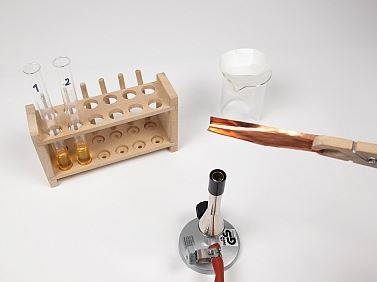Iodine reacts in alkaline solution with methylene groups which contain a neighbouring hydroxyl or carbonyl group under the formation of triiodoalkanes. By the reaction with ethanol, one of the products is triiodomethane (iodoform), which precipitates out as a yellow solid:
CH3CH2OH + 4 I2 + 6 NaOH → CHI3 + HCOONa + 5 NaI + 5 H2O
As methanol does not contain such groups, it cannot react to triiodomethane under the given conditions.
The differences between methanol and ethanol will be carried over to the experiment with longer-chain alcohols which follow (P7172100), so that the homologous series of the alkanes can be derived from the experimental data.
Advanced courses: The iodoform reaction can be used as an example for the discussion of aliphatic electrophilic substitution reactions.
Learning objectives
- The two substances can be distinguished from each other by the fact that ethanol in contrast to methanol reacts with alkaline iodine/potassium iodide solution forming a yellow precipitate.
- The yellow precipitate consists of triiodomethane, which can be shown to be a halogenated alkane by the Beilstein test.
Benefits
- Easy teaching and efficient learning by using interactive experimentation PHYWE-Software
- Experiment is part of a complete solution set with experiments for the topic Organic Chemistry matched with international curriculum: all topics are covered



